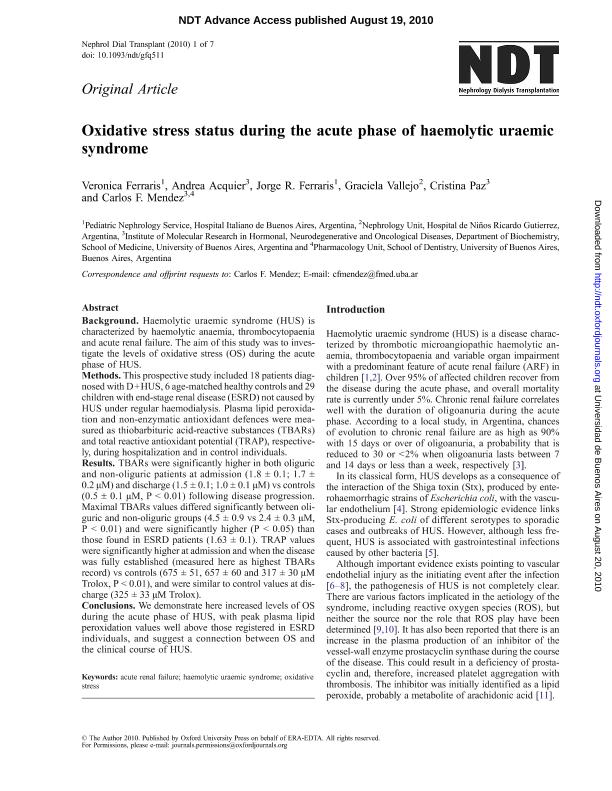Artículo
Oxidative stress status during the acute phase of haemolytic uraemic syndrome
Ferraris, Veronica; Acquier, Andrea Beatriz ; Ferraris, Jorge R.; Vallejo, Graciela; Paz, Cristina del Valle
; Ferraris, Jorge R.; Vallejo, Graciela; Paz, Cristina del Valle ; Mendez, Carlos Fernando
; Mendez, Carlos Fernando
 ; Ferraris, Jorge R.; Vallejo, Graciela; Paz, Cristina del Valle
; Ferraris, Jorge R.; Vallejo, Graciela; Paz, Cristina del Valle ; Mendez, Carlos Fernando
; Mendez, Carlos Fernando
Fecha de publicación:
19/08/2010
Editorial:
Oxford University Press
Revista:
Nephrology Dialysis Transplantation
ISSN:
0931-0509
Idioma:
Inglés
Tipo de recurso:
Artículo publicado
Clasificación temática:
Resumen
Background. Haemolytic uraemic syndrome (HUS) is characterized by haemolytic anaemia, thrombocytopaenia and acute renal failure. The aim of this study was to investigate the levels of oxidative stress (OS) during the acute phase of HUS. Methods. This prospective study included 18 patients diagnosed with D+HUS, 6 age-matched healthy controls and 29 children with end-stage renal disease (ESRD) not caused by HUS under regular haemodialysis. Plasma lipid peroxidation and non-enzymatic antioxidant defences were measured as thiobarbituric acid-reactive substances (TBARs) and total reactive antioxidant potential (TRAP), respectively, during hospitalization and in control individuals. Results. TBARs were significantly higher in both oliguric and non-oliguric patients at admission (1.8 ± 0.1; 1.7 ± 0.2 μM) and discharge (1.5 ± 0.1; 1.0 ± 0.1 μM) vs controls (0.5 ± 0.1 μM, P < 0.01) following disease progression. Maximal TBARs values differed significantly between oliguric and non-oliguric groups (4.5 ± 0.9 vs 2.4 ± 0.3 μM, P < 0.01) and were significantly higher (P < 0.05) than those found in ESRD patients (1.63 ± 0.1). TRAP values were significantly higher at admission and when the disease was fully established (measured here as highest TBARs record) vs controls (675 ± 51, 657 ± 60 and 317 ± 30 μM Trolox, P < 0.01), and were similar to control values at discharge (325 ± 33 μM Trolox). Conclusions. We demonstrate here increased levels of OS during the acute phase of HUS, with peak plasma lipid peroxidation values well above those registered in ESRD individuals, and suggest a connection between OS and the clinical course of HUS.
Palabras clave:
ACUTE RENAL FAILURE
,
HAEMOLYTIC URAEMIC SYNDROME
,
OXIDATIVE STRESS
Archivos asociados
Licencia
Identificadores
Colecciones
Articulos(INBIOMED)
Articulos de INSTITUTO DE INVESTIGACIONES BIOMEDICAS
Articulos de INSTITUTO DE INVESTIGACIONES BIOMEDICAS
Articulos(OCA HOUSSAY)
Articulos de OFICINA DE COORDINACION ADMINISTRATIVA HOUSSAY
Articulos de OFICINA DE COORDINACION ADMINISTRATIVA HOUSSAY
Citación
Ferraris, Veronica; Acquier, Andrea Beatriz; Ferraris, Jorge R.; Vallejo, Graciela; Paz, Cristina del Valle; et al.; Oxidative stress status during the acute phase of haemolytic uraemic syndrome; Oxford University Press; Nephrology Dialysis Transplantation; 26; 3; 19-8-2010; 858-864
Compartir
Altmétricas



